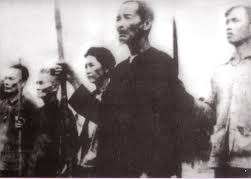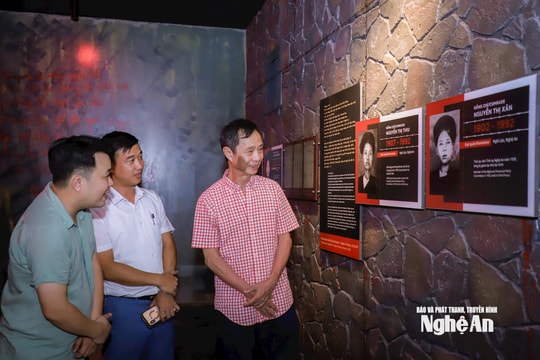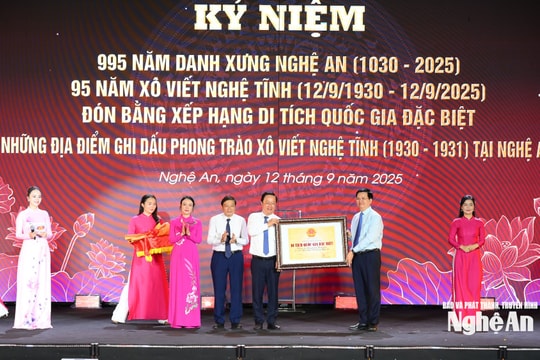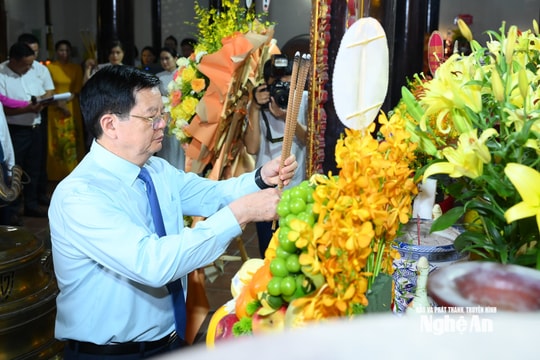Typical worker-peasant self-defense team in the Nghe Tinh Soviet movement
(Baonghean.vn) - The worker-peasant self-defense teams were born one after another under the leadership of the Party Central Committee, directly by the Northern, Central, and Southern Party Committees and local Party committees and Party cells in factories, plantations, and villages in the years 1930-1931. Thisis the core force to protect and support the masses in strikes and demonstrations everywhere, turning the two provinces of Nghe An and Ha Tinh into "Red Nghe - Tinh".
In the early months of 1930, under the leadership of the local Party Committee, a series of struggles broke out in Nghe Tinh. The first was a strike by workers at the Thai Hop and Lao Xieng Sawmills (March 13); strikes by workers at the Alcohol Factory (March 16) and the Match Factory (April 22).
To deal with the strong development of our people's struggle movement in all localities of Nghe - Tinh, the French colonialists on the one hand promised to carry out the demands of the workers and farmers; on the other hand, mobilized a large force of soldiers and police to focus on suppressing the revolutionary movement.
Faced with that situation, the Party Committees in Nghe An and Ha Tinh quickly organized worker-peasant self-defense teams (Red Self-Defense) as the core force to support and protect the people's struggle.
 |
| Red Guard Team of Phuc Son Commune (Anh Son). Photo courtesy |
At the end of June 1930, the Ba Xa self-defense team (now Hau Loc, Can Loc) was established. In other localities, Party cells selected loyal, healthy young men from trade unions, farmers' associations, and the Communist Youth Union to join the self-defense teams. The team members' weapons were mainly sticks, spears, lances, sickles, hammers, and pliers.
On August 30, 1930, Nam Dan District Party Committee mobilized 3,000 farmers to march into the district capital to demonstrate their power. In the early morning of September 1, 1930, more than 20,000 farmers, with the support of Red Self-Defense Forces and armed masses, marched to destroy Thanh Chuong district capital, then returned to their villages to punish the reactionary district chiefs and take control of the locality.
Next, the worker-peasant self-defense teams played the role of the core force to protect and support the masses in strikes and demonstrations everywhere, turning the two provinces of Nghe An and Ha Tinh into "Red Nghe - Tinh", shaking the entire governing apparatus of the French colonialists and their feudal lackeys. The French colonialist government in many villages in Nghe Tinh completely collapsed and became paralyzed.
Facing favorable conditions, Soviet governments were established in many rural areas of Nghe Tinh. The revolutionary movement led by local Party Committees with the support of Red Self-Defense teams developed increasingly strongly, becoming the peak of the movement nationwide.
In order to deal with the revolutionary climax in Nghe Tinh, the French colonialists launched a "white terror" campaign. Directed by the Party Central Committee, the Central Region Party Committee and the provincial, district, and communal Party cells in Nghe An and Ha Tinh provinces directed the Soviet governments to build and develop Red Self-Defense teams in the form of the "Worker-Peasant Red Army".
In Nghe Tinh, there were 9,050 Red Guards, including 322 suicide squad members in Can Loc district and hundreds of female suicide squad members. Depending on the conditions of each village and commune, the Red Guards were organized into squads, platoons, and companies; the strongest and most loyal people were assigned to the suicide squads.
 |
| Red Guards in Hoa Quan - Dong So - Nghe An (1930-1931). Documentary photo |
In 1931, the Indochina Governor-General's Palace sent 150 more soldiers in blue uniforms from the North to Nghe Tinh. They set up secret police stations in the two provincial capitals of Nghe An and Ha Tinh; at the same time, they concentrated their forces to carry out brutal terrorism, causing difficulties for the Party organization and mass organizations in many villages and communes.
Faced with that situation, Leader Nguyen Ai Quoc paid special attention to the organization of self-defense forces in Nghe - Tinh. He stated: "The organization of self-defense of farmers is very important in the struggles in the villages and communes. The Farmers' Association must propagate and explain to the masses the significance of establishing a self-defense team to protect and call on the masses to participate." In April 1931, the Central Region Party Committee issued the Charter on the organization of the Red Self-Defense Team.
In June 1931, Nghe An and Ha Tinh had 411 self-defense teams with 9,148 members, including hundreds of suicide squad members and female self-defense teams. During the day, the Red Self-Defense team members participated in production, and at night they conducted military training.
Faced with the enemy's fierce terror, to preserve their forces and prepare for a long-term struggle, from June 1931, Party organizations in many places withdrew into secret activities. Most of the self-defense members were scattered among the masses, and a part withdrew into secret activities following Party organizations.
The worker-peasant self-defense teams in the Nghe Tinh Soviet movement were the initial armed forces that the Party continued to inherit and creatively apply in building guerrilla and self-defense fighting teams, together with the main force and local troops as the core for the entire people to successfully carry out two resistance wars against French colonialism and American imperialism./.
Pear Flower
(Synthetic)
| RELATED NEWS |
|---|









